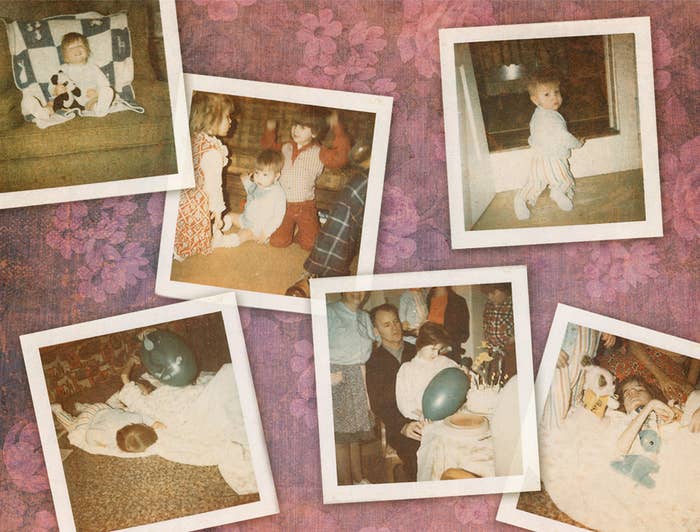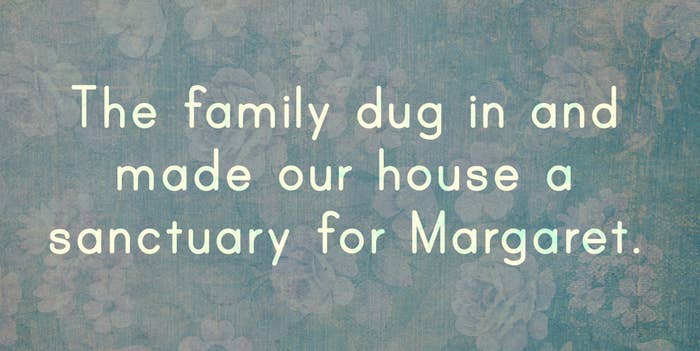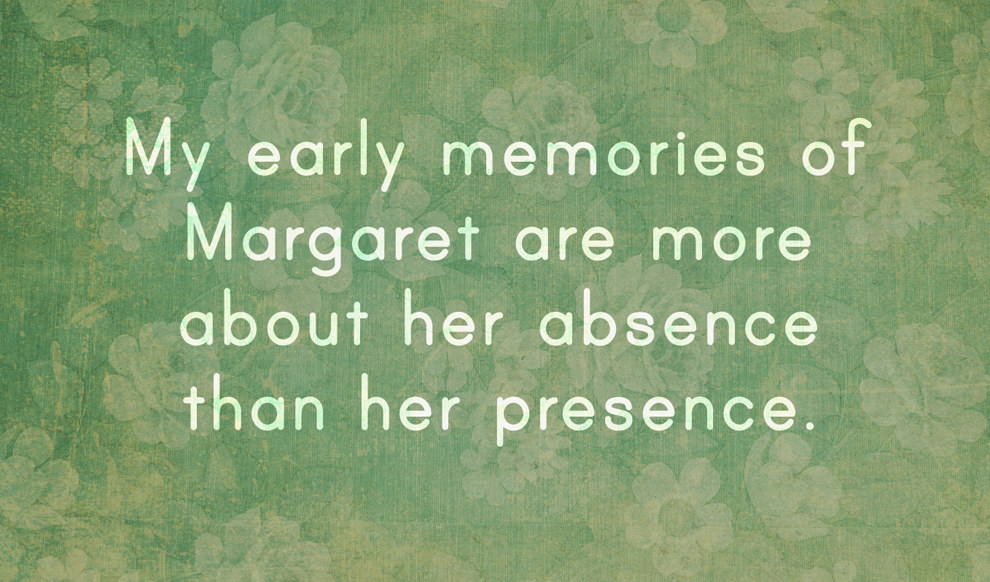
In the dream I am in my childhood home. I am standing in the doorframe of my sister Margaret's room, watching her unpack her bags from a semester at college. For some reason she is always returning from a semester at college, even though she'd be in her fifties by now. I stand there, transfixed — not just because Margaret is standing in her bedroom, or because she's getting a college education, or simply because she's alive and vibrant in this impossible present moment. It's that when I enter the room, she speaks to me. I hear her voice. This is always the thing that stays with me when I return to the waking world. Her voice, in my dreams, is somehow clear and familiar and utterly alien at the same time. Because Margaret never spoke a single word in her life — a life that ended before I could begin to understand it for what it really was.
Three days after Margaret was born, the doctor met with my parents in his office. He had some bad news: Margaret was blind. Her eyes had never fully formed in the womb, a sign that something had gone wrong early on in my mother's pregnancy. The doctor told them to adjust their expectations for Margaret and discharged them from the hospital. While my father drove home in silence, my mother held Margaret in her arms and wondered how she would raise a child who would never see her face. She thought about how she would break this news to my brother and sisters, who were at home watching Bonanza on the living room rug. She entertained the possibility that Margaret's blindness was a punishment from God, but then quickly dismissed it. God didn't work that way, she thought. Margaret was a gift, she decided, and she just had to figure out how to unwrap it.
Four months later, my parents met with Margaret's pediatrician in a wood-paneled office that looked out on a supermarket parking lot. He was concerned that her development was not on track for a blind child. She was showing significant delays along several axes, which suggested that the blindness would be the least of her issues. The pediatrician speculated that Margaret would never walk, that she would never be able to attend school or dress herself. She would never talk. He was firm with my parents — they should not go chasing after doctors who claimed they could cure Margaret. Her disabilities were so many and so profound, the pediatrician said, that there was no possibility her condition would ever improve. The best my parents could do, he said, was to love their daughter for the person she was.
They initially dismissed the test data, determined to raise Margaret as a "normal" child. But as she grew, her disabilities became more pronounced. She failed to hit any of the developmental milestones my brother and sisters had passed without incident. Her eyes were perpetually closed, and she flapped her arms and lolled her head, and after a few tentative trips to the grocery store where Margaret drew prolonged stares from neighbors, my mother decided it was best to keep her home where she would be safe from condescending scrutiny.

The family dug in and made our house a sanctuary for Margaret. My parents bought a special hospital crib for her — a fearsome, cage-like apparatus that ensured she wouldn't fall to the floor in the night. A local handyman built a special chair to make it easier for them to feed her. We constructed a moat of silence around the house. There was a world outside and a world within, and we took an unspoken oath to keep Margaret's presence a closely guarded secret — so much so that we rarely spoke of her at all. And in the vacuum of this collective silence we developed a fearful reverence for her, as if she were some kind of damaged angel who'd fallen through our roof — an alien being whose survival required superhuman reserves of vigilance. Our house became a convent, a devotional space of whispered prayers. We couldn't express anger or frustration, because to do so would be to question God's authority and the very order of the universe. My mother shunted her grief with tranquilizers, periodically locking herself in the family station wagon so that she could weep without being discovered by my father, who bore the duty of Margaret's care as though it was preordained.
As Margaret grew older, her health worsened and her needs became more complex. In July of 1969, on the recommendation of their priest, my parents drove Margaret to Craig Developmental Center in Sonyea, N.Y., 11 miles from our house. As the crew of the Apollo 11 rocketed toward the moon, my parents lay Margaret in a specialized bed, placed her favorite stuffed animal — a blue rabbit — next to her, and returned home in the dark, driving past corn fields and the local salt mine, parking in the driveway just as the astronauts orbited past the Sea of Tranquility.
My early memories of Margaret are more about her absence than her presence. My parents kept the large metal crib in her room so that they could bring her home for holidays, and in its empty cell I often played a game of "prisoner" with my friends. There were pictures of her everywhere, close-ups of her in her bed, her eyes forever closed, grinning at something inside her mind that we could never access. My parents visited her every Sunday, returning late in the afternoon smelling of the industrial-strength cleaning agents. They were at the facility so often that I told my kindergarten teacher that my mother worked there.

Occasionally my parents would take us with them on their visits. I remember the Craig Center as a massive, dimly lit warehouse, filled with rows of beds cordoned off by gray, pleated curtains. We stood awkwardly and watched as my mother stroked Margaret's hand and played cassette tapes of folk music she said Margaret loved. And Margaret would smile and turn her head yearningly toward my mother as though she'd just returned from a distant land. Although her limbs were thin and rigid as a result of a stroke she'd had as an early teen, she was incredibly expressive. It could have been the music that made her happy, or it could've been the sensation of my mother's hand, her fingertips brushing against Margaret's cheek, or the sound of her voice, describing Margaret's beauty. It was impossible to know, and that was what I feared most about being in my sister's presence. As I stood in front of her chrome hospital bed, I could see in Margaret's face that she was my sister, but I knew nothing of what went on inside her mind. There was a gap between us. A chasm that I assumed could only be bridged by words.
Language is a uniquely human ability — so much so that it's hard to even imagine how we could exist without it. But the areas of Margaret's brain that would have made language possible never developed. No amount of coaching or therapy would ever tease a sentence out of her. There could be no Helen Keller breakthrough moment where she'd suddenly realize that the water running through her hands had a name. She was fated from birth to live in a world of silence. Her mind was a walled citadel, the secret interior of which, gloriously detailed or shaded and gray, was hers alone to know. But what did she think about? How did Margaret understand the world? Who did she love, and how? And who was I to her? I could not answer this question, and it haunted me as a child. And because I was scared, I stepped back while my parents leaned in. I remained aloof while they sang to her and held her and stroked her hair by the window that looked out onto the handicap-accessible playground in the distance. While they struggled to interpret her gestures and express their love for her, to make it known through touch and sound and warmth that she belonged to a family, I hovered along the back wall and waited until it was time to leave.
And then, on the night of Oct. 6, 1988, Margaret's lungs filled with fluid and she passed away in the hospital. I woke up in the middle of the night to the phone ringing in the hallway. I knew who was calling but I lay rigid in my bed and waited for someone else to pick up. I heard my mother break down in the kitchen after receiving the news, and I thought about Margaret's last moments. Did she know she was dying? And did she wonder where her parents were, why they weren't there holding her hand as she struggled to breathe? How did she make sense of her life? How could she even know what "life" was, without having a word for it? Her death, so sudden and unexpected, shook me, knocking loose all the questions I knew I'd never answer.

Twenty-five years passed, and all the unanswerable questions retreated into some dark recess of my memory. Then, in 2011, my friend Eli Horowitz approached me about a project he was working on — a collaborative novel about a generation of children born without the ability to produce or understand language, told from the perspective of the people around them: the parents, health care professionals, teachers, friends, cult members, cops, and fanboys whose lives were changed forever by their interactions with these children. It seems strange to me now that I didn't immediately think of Margaret when I agreed to help Eli out, but I didn't make the connection until we released The Silent History. Once the book was out of my hands, I could see that, in writing it, I was reaching out to that younger version of myself — the boy who stood at the back of Margaret's room, unable to step forward and make contact. The boy who'd spent so much time focusing on what Margaret lacked that he failed to acknowledge the things she possessed.
The Silent History revolves around the same questions I was left with in the wake of Margaret's death. How does language define who we are? Is it a tool we use to express ourselves or is it a filter that constrains what we can think about? No words ever took shape in Margaret's mind — what might it be like to be free from the constant internal monologue that defines the experience of a talking person's life? Who are we behind the stories we tell ourselves, the chatter of interpretation and justification?
As a writer, I have a built life around words. For me, language is the critical tissue that connects people. It is the raw material for human civilization — an element so essential that it's impossible for me to imagine an experience beyond its borders. When I dream of Margaret speaking to me, it is like I have finally found the keys to a door I could never open in the years she was alive. But the world still exists, with or without language. It will continue, with or without our books and conversations and soliloquies. And Margaret was still a person, even though I never heard her voice.
With each passage I wrote, I came ever closer to her bedside. Although I missed the chance to know the real Margaret in the way my parents were able to — through touch, sound, warmth, a communication beyond language — I have this pale substitute in The Silent History: a 513-page description of my hand reaching out, struggling to make contact with my sister, coming close but never quite touching down on the surface of her skin.
***
Matthew Derby is an author of The Silent History, the first major exploratory, interactive novel designed specifically for the iPad and iPhone, now also available in a print edition from Farrar, Straus and Giroux. He is also author of Super Flat Times: Stories (Back Bay Books). His stories have been anthologized in The Anchor Book of New American Short Stories and The Apocalypse Reader, and his writing has appeared in McSweeney's, Conjunctions, The Believer, The Columbia Journal, Fence, and Guernica.
Learn more about The Silent History here.

